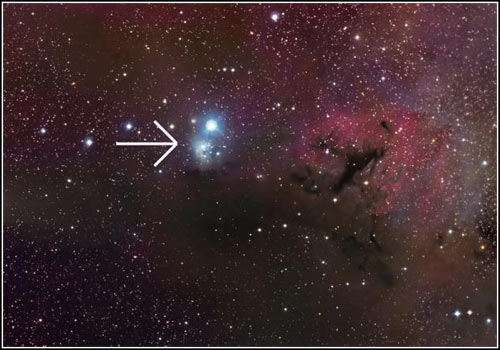Detecting the youngest and smallest mass dwarf in the vicinity of the Sun.
Astronomers have found three brown dwarfs with an estimated mass of less than one-tenth of Jupiter's mass - these are the youngest and smallest mass objects discovered in the vicinity of the Face. Heaven so far.
This observation was conducted by a group of astronomers working at Laboratoire d'Astrophysique de l'Observatoire de Grenoble (LAOG) of France using the Canadian-French-Hawaii telescope (CFHT). Andrew Burgess will present this discovery at the European Week of Astrophysics and Astronomy at Hertfordshire University, Hatfield on Wednesday (April 22).
Dwarfs are formed in a star-forming region called IC 348 , located about 1,000 light-years away from the Solar System towards the constellation Perseus. This region is approximately 3 million years old - relatively young compared to our Sun 4.5 billion years old. It is this feature that suggests this is a good place for us to search for small mass brown dwarfs . These dwarfs are alone in the void, they do not orbit any other star even in terms of gravity they are attracted towards IC 348. Their atmospheres all show methane uptake. ; This is the characteristic to select and identify these young objects.

IC348 , star-forming region, where brown dwarfs have been discovered (Photo: Adam Block and Tim Puckett)
'There are some disagreements around the identification of young, small mass brown dwarfs in this region. An object of similar mass was discovered in 2002, but some research groups have argued that it is just a close-up image coinciding with the line of sight for a lighter and older brown dwarf. In fact, we have found three low mass dwarfs towards IC 348, which supports the conclusion that these are really very young objects , "Burgess said.
The team began searching for this population of brown dwarfs to help theorists develop more accurate mass distribution models in new formations, including massive stars and dwarfs. Brown, to do this requires a review of the theory of existing star formation. Detecting dwarfs in the IC 348 region allows them to generate new statistics about the smallest mass of an object in the universe.
' Finding 3 dwarfs with a small mass in the direction of IC 348 confirmed the previous prediction of the number of small mass objects growing in a star population. Brown dwarfs cool down with their age and current models estimate that their surface temperature is around 900-1000 degrees K (ie 600-700 degrees C). This is a really low temperature for newly formed objects, which means they have the lowest mass of all the stars we've ever known before, 'Burgess said.
- Discover a mysterious companion star
- Detecting the minimum mass of the galaxy
- Rare dwarf elephants die in mass
- The shocking truth about the smallest dwarf planet of the solar system
- What does the world's youngest bug look like?
- Nobel laureate scientist makes the world's smallest mass spectrometer
- Detecting the youngest alien planet
- Medical mystery: The youngest person in the world
- 10 species of 'tiny' animals in the world
- Detecting Goblin dwarf planet redefines the Solar System
- For the first time, the scientific community determined the mass of a star
- Korean scientists first discovered medium mass black holes
 Van Allen's belt and evidence that the Apollo 11 mission to the Moon was myth
Van Allen's belt and evidence that the Apollo 11 mission to the Moon was myth The levels of civilization in the universe (Kardashev scale)
The levels of civilization in the universe (Kardashev scale) Today Mars, the sun and the Earth are aligned
Today Mars, the sun and the Earth are aligned The Amazon owner announced a secret plan to build a space base for thousands of people
The Amazon owner announced a secret plan to build a space base for thousands of people How do astronauts weigh when floating in space?
How do astronauts weigh when floating in space?  1g of salt dissolved in 1g of water, why is the total mass not 2g?
1g of salt dissolved in 1g of water, why is the total mass not 2g?  Why is Jupiter not considered a star?
Why is Jupiter not considered a star?  Mass graves in Peru reveal dozens of women living and dying with weaving?
Mass graves in Peru reveal dozens of women living and dying with weaving?  New breakthrough in black hole research helps find 'missing link' in the universe's 10 billion year history
New breakthrough in black hole research helps find 'missing link' in the universe's 10 billion year history  How do scientists measure the mass of a star?
How do scientists measure the mass of a star? 